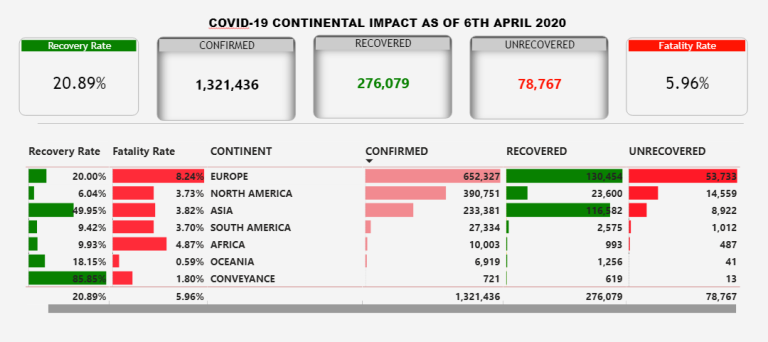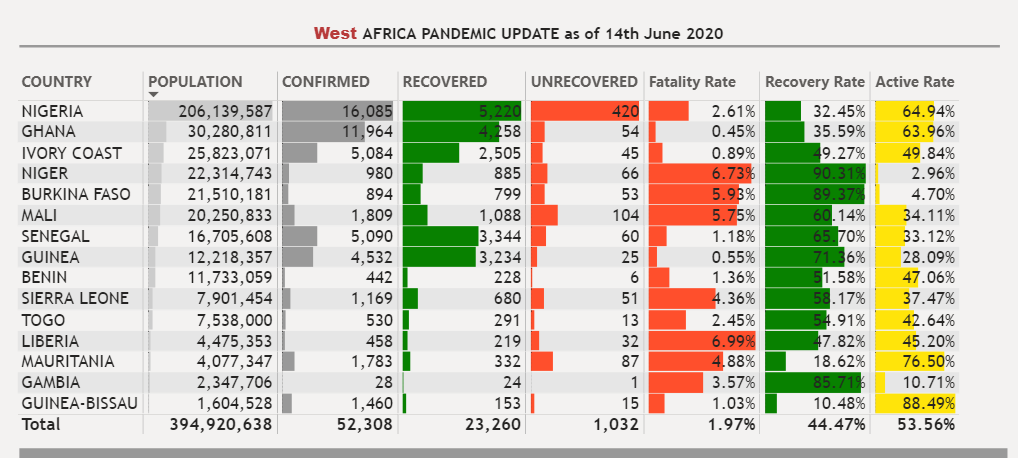The interactive Power BI report follows the short narrative
The cataclysmic change from the novel coronavirus pandemic tested the resilience and leadership disposition of all nations; many, including developed countries/regions, discovered with dismay the inadequacy of their medical emergency response systems. Some, more than others, had been able to interpret the data emerging from the virus infection and use the knowledge to halt its rapid spread. Those slow to react experienced higher rates of infection and mortality among the people. Influence of Data had never been more evident than during the coronavirus pandemic, proving that the success of every venture, social or economic, must not only be anchored on well-thought-out plans but must rely on reliable information derived from sufficient and proficient data.
Several global, regional and national reports on the corona pandemic are available on the internet, but only a few had paid more than passing attention to Africa. The following report aims to provide basic insights into the COVID-19 impact on the African continent. The data for the nCoV19 Pandemic Report–Focus on Africa was sourced from the GitHub repository as curated and made available by the Johns Hopkins University Centre for Systems Science & Engineering. Other sources include the Nigeria Centre for Disease Control and the National Bureau of Statistics. Refer to the INFORMATION page in the Report for more details.
To give the reader distinct and relatable information on the impact of COVID-19 on nations, the report has been scaled into Global, African, Regional and Nigerian sub-reports. The two pages at the end of the report are comprehensive details of the COVID-19 data presented in tabular form.
April 6th, 2020 was selected to benchmark analysis in this report. It marks the midpoint between 22nd Jan 2020, the date data on the pandemic was made publicly available, and the date this article was published. On this day, every country/region had come to the full realization of the existential threat of COVID-19; the only continent with no recorded case was Antarctica which has no indigenous inhabitants.
The reader would have an immediate appreciation of the growth of the pandemic by comparing data of different periods that can be selected on the live and interactive Power BI report at the bottom of this post. The following briefs would explain some of the basic insights that the report offers.
Global Pandemic Report
The Global Report page tracks the continental aggregations of reported cases and provides context to the sub-reports. Table 1.1 shows the distribution of confirmed cases among the six populated continents as of 6th April 2020, while Table 1.2 shows the impact per a population of one million.


It is instructive that, 60% of the world population of 7.4 billion is in Asia, the epicentre of the pandemic, which accounted only for 17.70% of the global confirmed cases as of 6th April 2020. Africa, the 2nd in population, recorded the second least number of cases after Oceania, the least populated of the six inhabited continents. Europe, accounting for 10% of the world population, recorded the highest number of cases at 652,327.
By 14th June 2020, the COVID19 global map had been reshaped. Table 1.3 is a summary, showing an increase of 497.90% over the April 6th recorded numbers. North America recorded the highest number of deaths, least recovery rate but second highest mortality rate.

Africa Pandemic Report
According to Wikipedia Africa is home to an estimated 1.2 billion people, representing 16 % of the global total. Regardless of the political disputes, Africa comprises 55 countries in 5 geographical regions as indicated in Table 2.1

Summary of the impact of the pandemic by April 6th is contained in Table 2.2 below, while Table 2.3 shows the pandemic update on 14th June 2020, which displays a sharp contrast.


Regional Highlight
There are two significant insights the Africa Report has revealed pertaining to the East and Central African regions. First, Central Africa, comprising nine countries, which was once the epicentre of the Ebola pandemic, recorded the second-lowest count of confirmed cases as of 6th April 2020. However, in relative terms to both the population and the number of the confirmed cases, suffered the highest COVID-19 mortality rate on the continent. The inverse relationship between fatality and recovery rates means the region had the lowest rate of recovery from the infectious disease, as well.
The North African region, comprising seven countries, had the highest number of confirmed cases and fatality rate in comparative terms. Factors such as proximity to Europe, particularly Italy, and sharing similar climatic conditions, could have influenced the rapid spread of the virus to the Arab nations.
The second highlight is a perspective on Madagascar, one of the 18 countries in East African. Often described as geologically a sub-continent, ethnographically South-East Asian, it is geographically the fourth largest island in the world located on the southeast coast of African. Madagascar had 304 confirmed cases, 114 were recovered, 190 undergoing treatment and ZERO death by 17th May 2020.
The President of Madagascar had claimed and, indeed, staked his reputation on the efficacy of a herbal solution he had manufactured as a cure for the coronavirus infection. There was a public launch of the product that he later made a generous allocation of to several African nations.
The discovery was greeted with enthusiasm in Africa but with the expected scepticism around the globe, including a call for caution from the World Health Organization (WHO). However, the recent pronouncement by WHO that where a system of medicinal practice had persevered for over 200 years amongst any society that system should stand recognized. This is a welcome development coming on the heels of several tested claims of the potency of African organic medications.
When Africa unites to establish a continental body, Africa Health Organization, for instance, for the study and research into African medicines, results that could delight both investors and political leaders would likely be achieved. The main challenge, however, would be how to negotiate the monolithic corporations controlling the global pharmaceutical industry.
Senegal was another African success story, proving again the resilience and resourcefulness of the African community when faced with an existential threat. This West African nation of 17 million people established one of the most successful systems of administration and management of the COVID-19 pandemic in the world. It brought down the cost of a single unit of test kit from $61 to just $1 and produced all the ventilators it required at just $60/unit as against the global price of $16,000. The story is available here.
The sudden increase in the spread of the coronavirus in the Southern African region should alarm the African Union. With only 5 nations, the region has the least number of nations and the lowest aggregate population as well. However, the region has recorded a jump of over 4000% rate of growth in COVID-19 confirmed cases per population of 1 million against the regional average of 2000%. Table 2.3 below compares the position between the April 6th and June 14th, 2020.

West Africa Pandemic Report
With an aggregate population of 340 million, the West African Region comprises 16 nations that make up the Economic Community of West African States (ECOWAS) and ranks second in population size after East Africa. Nigeria, where ECOWAS is Headquartered, holds 52.15% of the region’s population and is the most populous country in Africa as well as its largest economy. When Nigeria closed its borders on 14th October 2019 for economic reasons, the measure was widely regarded unpopular among the neighbouring States. With the benefit of hindsight from the COVID-19 development, however, it was hailed as a significant contributor in stemming the cross-border spread of the coronavirus. A summary of the impact status on the region as of 14th June 2020 is captured in Table 3.1 below.

Given its population size, the commercial and social propensities of its people, it was less of a surprise that the number of confirmed cases recorded by Nigeria was the highest in the region as of 14th June 2020. Maintaining correlation with population size, Ghana recorded the second-highest number of cases in the region. Liberia’s mortality rate of 6.99%, the highest in the region, deserves a mention and attention.
Nigeria Pandemic Report
According to several sources quoted from data supplied by the United Nations, Nigeria’s 2020 population estimate of 206 million, representing 2.64% of the global total, is ranked 7th on the list of countries. It is also regarded as the most populous black country in the world. These metrics, which point to great economic and political potentialities, are responsible for some of the attention Nigeria attracts from the global community. The socio-economic implication of the closure of Nigeria’s borders pre-COVID and beyond as discussed earlier was one of such impacts.
The number of cases recorded by the country’s Centre for Disease Control as of 14th June 2020 was 16,805. With an active rate of 64.94% and mortality under 3%, Nigeria demonstrates a notable resilience of the African nations not unlike the type it demonstrated on the onset of the July 2014 Ebola outbreak. The institutional memory from the effective management of the Ebola outbreak would appear to have significantly contributed to the COVID19 structure established to manage the coronavirus pandemic. A dedicated Nigeria COVID-19 Report is available here
Final Thoughts
The COVID-19 Report has been presented in a story-like form, a popular culture in data analysis and reporting environment that has been adopted in providing clarity on data-based issues and structures. The knowledge shared is intended to lead to the formulation of measures against the COVID-19 scourge and support a new architecture of a reliable response framework against similar occurrences in the future. Business Intelligence and Analysis tools such as the Microsoft Power BI have eased the extraction and transformation of massive amounts of data to help reveal timely insights for actionable decisions.
In the future, daily disease forecasts channels would most likely evolve, similar to the ubiquitous weather channels, to broadcast warnings that would enable us to take preventative and remedial actions without waiting for belated government interventions. The evolution of such outlets would be driven by Data Merchants, entrepreneurs of actionable data for sale. They will substitute government information organs to bridge the information gap and profit from the opportunities. Events such as the one reported by Forbes in the United States of America present the perfect scenario for the new enterprises. Forbes reported a study published revealing that:
Around 54,000 coronavirus-linked deaths in the U.S. could have been avoided by early May if states issued coronavirus restrictions on March 1, 2020, according to a new Columbia University model that starkly demonstrates how early action might have curtailed the growth of the virus
The fact that if requisite warnings had been issued on time, 54,000 people could have been alive today, would continue to resonate with most Americans. A sub-conscious sensory memory for self-preservation has been created and would provide the perfect trigger target to the data merchants to formulate and offer customized on-demand information to willing clients.
Cloud computing powered through Artificial Intelligence, Machine and Deep Learning would continue to advance technological developments and the creation of opportunities that are yet to be fathomed. While many appear to resist and even regard the changes as digital sorcery, the new world order isn’t going to reverse itself but will continue to evolve because data has, indeed, become the new oil and forms the bedrock for all forms of human advancement.


You may reply here, please